EGR FAILURE ?
(old page, see new here)


Is you our Dash Speedo cluster CHECK ENGINE LAMP is glowing?
Excess EGR flow can infact stall and engine by totally upsetting Oxygen & combustion.
I will try to cover all variants, and it is a complex system. ( only do to the variants)
This page has grown out of control (sorry) and I will reformat it for generations.(soon)
I started this page with only 8 valve EGR tests.
89-90, 91 to 94, 94 to 95, 96 to 99. There are 4 generations.
The 99 cars have single valve EGR and all the brains are in the ECU. ( 99+ clean the valve and pray)
On the older cars we have the below systems.
Problems:
You pulled the DTC codes and it shows Code 51(OBD1) or P0400 (OBD2) !
Or your car runs like crud, or wont idle for beans.
Mind set:
On all cars 98 and older: (simplistic)
DO the :
- Stall test, then....
- Live test.
If the stall test passes, do the live test.
If the live test fails, you have bad EGR valves ( up to 3 valves on 96 and newer Kicks and Trackers. )
If the live test passes. then look for restrictions.
On the oldest of Sidekicks 89-92 and not Calif. E33 models , your car runs real bad
and you do not get any DTC or CEL lamp ( on the old models there is no EGR monitor!)
Scope 1989 to 1999: (but my primary focus is 91 to 98) USA and CANADA.
If your car is throwing many other codes, you may have to leave diagnosing EGR codes to last. "So says the FSM."
The same goes, for a badly running engine, weak cylinders, stuck intake head valves or dead sensors.
A bad TPS, VSS, MAF/MAP can cause the EGR test (monitor) to start at the wrong time or conditions, creating a false positive warning. Is this Jagon hard?
The most common order of repair is:
Almost all CEL DTC's are real and correct the EGR system is bad, as the code says.
- Clean the EGR main valve. ( not leaking! not stuck open, not cracked , no leaking air from outside, to the inside)
- Clean the whole PATH end to end !!
- Do a stall test.
- Do a live test.
- Test the VSV functions, vacuum
solenoid valve.
What is a P0400 Monitor and How does it work? ,the FULL story here ! 96-1999+)
This is a complex topic. so a reformat is in order.
Public enemy #1: The MAIN EGR VALVE. Photo # 1:
 Typical 8v engine, with
missing California thermo probe !
Typical 8v engine, with
missing California thermo probe !A Typical system 1998 system 1.6L , kinda scary, right? DWG1:
Older systems are very simular. 89 to 98 , later years vary greatly, see end of document for after 98 changes.
EGR functional matrix, this table shows the hardware type and how the software monitors work. (my theory, so not OEM table)
Engines below : (all 1.6L except where noted) Table-1:
| year or range |
Market |
OBD Monitored |
DTC code |
Thermo probe |
Methods |
| 89-91 |
All states |
No |
N/A |
No |
It works or it don't |
| 92-94 |
FED |
yes |
51 |
4 door yes, 2dr no. |
2 tests |
| 92-94 |
Calif |
yes |
51 |
Yes REGTS | 3 tests |
| 95 |
Fed and CAL |
yes |
51 |
Yes REGTS | 3 tests |
| 96-98 |
All states |
yes |
P0400 |
No |
2 tests |
| 96-98 Sport 1.8L |
All states |
yes |
P0400 |
No |
2 test. No VAC |
| 99+ no mod valves |
All states |
yes |
P0400 |
No (motor EGR) |
2 tests |
The 2 tests are Cruise test and a Deceleration test, the third test if thermo heat detect when EGR opens (for Calif).
The no vacuum EGR is used on all Suzuki Sports and all Vitara 99s and newer. The no Vacuum technology use a stepper motor driven EGR.
My 91 Tracker FSM from GM mentions a california model but the Suzuki models mention no word of this , nor is there a 91 calif. type ECU in the parts list.
Keep in mind some cars are running a newer ECM then what came orgionally with car. Check for the correct P/N ECU ,here.
This table is to the best of my knowledge and is not official Suzuki data.
Click here for my SIDEKICK EGR SHORT LIST:
Click here for my EGR Fast test, for a 1989-95 SideKick/Tracker.
PLEASE BE CAREFUL NOT TO BURN YOUR SELF TESTING THIS DEVICE (wear leather garden gloves , heavy duty)
THE "DTC":
A DTC is a Diagnostic Trouble Code, or as some call it a CEL code.
The "CEL" is the Check Engine Lamp.
EXHAUST GAS RECIRCULATION VALVE , failures:
I will not try to explain the whole technology and evolution of EGR controls, but if you are brave you can start here:
TO SEE THE WHOLE SYSTEM in schematic form , < click here.
Best EGR posts, best articles on exact car:
A very good EGR write up I found on a Suzuki forum
Another good write up on EGR fails.
My definition of EGR.
The whole purpose of this valve is to stop the generation of Nitrous Oxides, at the end of your tailpipe.
This method works by crudely lowering combustion temperatures ( by leaking Exhaust into the induction system)
Unfortunately this leaking is a nasty business, this system is infamous for clogging up the EGR main or causing it to stick wide open.
Tests:
On many cars, the EGR valve has the front of its diaphragm exposed. 89-98' this makes pushing it easier , do not get burned, it will be HOT.
The 8v EGR is easy to see and reach and the 16v up to 98 are very hard to reach. (it's on the back side on 16v engines 1.6L)
A quick History:
ALL 8 valve 1.6L kick engines look and work mostly the same (89 to 95). The only differences are the monitors if any and the calif thermo probe.
The EGR looks this HERE:
or a real 8v photo:
The only major differences, are how to do a live test. ( In neutral , parked or , on rear jackstands with rear wheels spinning) More later...
Review the different systems below:
92-95 EGR vacuum map (diagram)
96-97 EGR vacuum map.
1998 real engine bay map.
1.8L Sport engine EGR map.
Note: the 1.8L is devoid of VSV valves and Modulator valves ! It has stepper motor direct drive operation.
The 1.8L can not be stall tested , no vacuum and no skeletonized frame or vacuum diaphragm !
Below is typical of all 1.6L engines 1989 to 1998.
The exceptions are:
The EGR temperature probe is only on California cars in 1992/93/4 and then the probe, was added to all 1995 Sidekicks.
In 1996 the EGR thermo-probe was dropped and a new EGR MAP sensor was employed to test EGR functions.
In 1999 , the Vitara EGR has no MOD valve, probe or any vacuum lines at all, and is identical to the Sport 1.8L in 96-98.
This 6 pin electronic stepper motor driven EGR is HERE .
The ECU now takes full control of modulating the 6 pin EGR, no more wierd science like the below.
The below drawing is of California 92-95 EGR 1.6L 16v engine , EGR system: Drawing 2:
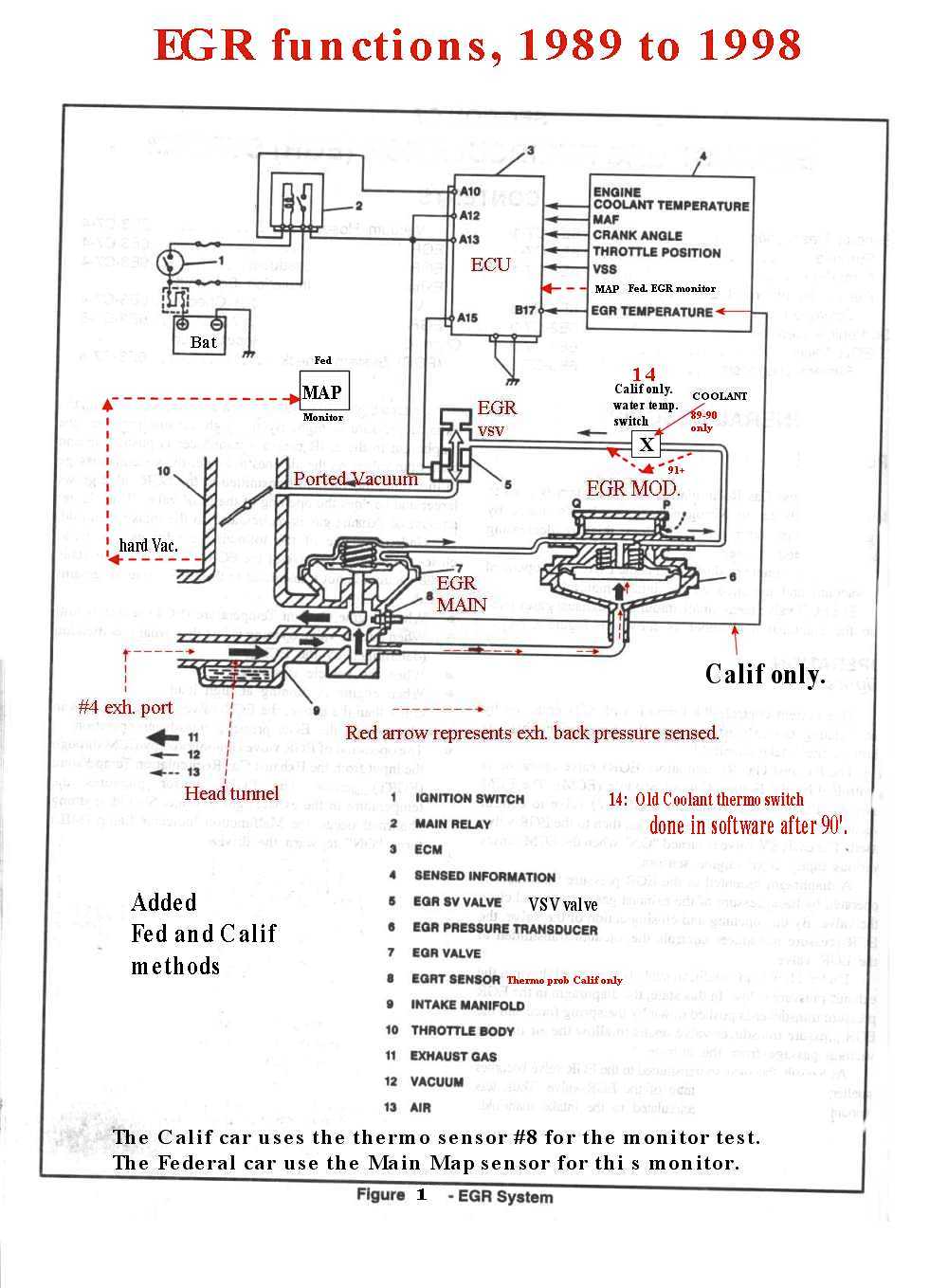
TESTING:
Most mechanics, will first conduct the stall test and then clean the system before trying to diagnose what is wrong.
This first test takes all of 1 minute and if it fails,the cleaning is a must, but even if the test passes cleaning can still be needed.
1996 , the cleaning has to be done more carefully. see the orifice photos at the end.
The remainder of this document will cover, doing all the tests, and more, details on cleaning.
89-95:
Running test, AKA: The STALL TEST.
Pressing on this diaphragm, must cause the engine to stumble and die, when the engine is at idle.
This action is because, Exhaust gases have almost no oxygen content, and inhibits combustion.
It must stall or almost stall. I've seen engine run at 300 RPM when depressed. Strong engines !
If the engine, does not stumble or die, then the passages in your EGR system, are fully or mostly clogged.
( Cleaning the system will Correct , most cars )
The stall test, can be done 2 ways:
Pushing on the diaphragm with the fingers, or with a hand held vacuum pump. " I use a MityVac tool" LESS BURNS !
Either way, this test must stall or almost stall the engine, while idling.
Harbor Freight (fright?) has a MityVac clone for $19. "made of brass and steel, very nice !".
The same tool helps you to bleed brakes too ! And test any vacuum operated device.
The 16v engine has the EGR main valve more hidden and a hand mirror helps you look at it, when it is in operation.
This mirror will save you from burned fingers.
What this stall test is doing is:
Moving the diaphragm by hand or with a vacuum tool MUST flood the engine with TOO much exhaust gas and cause engine to stumble and die.
On the 96 and newer, there is a hidden EGR orifice behind the throttle plate , IT MUST BE FULLY CLEAN.
The mechanic below removed the freeze plug and then glued it back in later ,with epoxy. (Don't do that, this is for illustration only !).
I do not recommend this , it is just to show how hard it is to clean this port, as you can see clearly here, you must fish a cleaning cable up and 90 degrees to the inboard side. I use a old broken speedo cable attached to a drill motor chuck, to clean it. THIS Works real good .
Those bottom 2 studs are where the EGR tube was mounted.
Photo #2: (up is up in view)
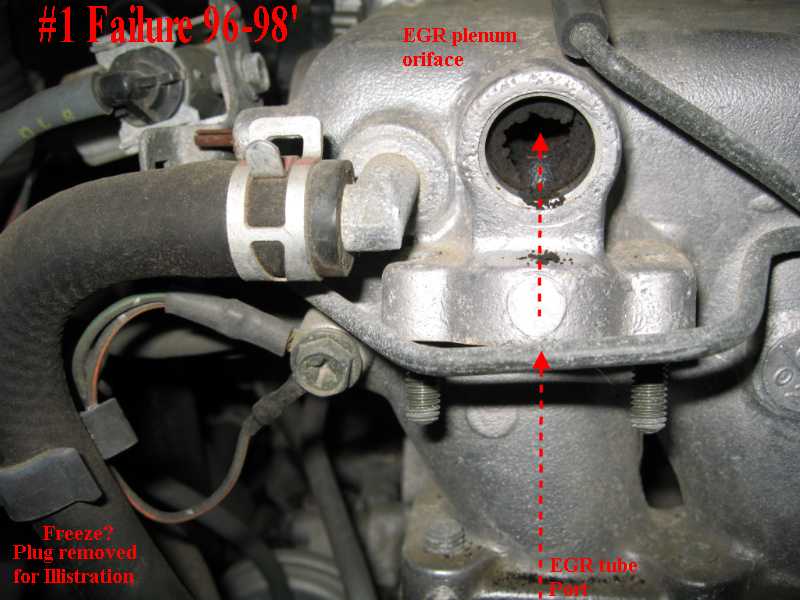
96-98:
Some times the above test passes and the orifice is restricted and as such , sets a EGR flow fail DTC. P0400. (51)
If the above test, passes, then test the EGR valve by applying vacuum, to the main valve directly with an engine vacuum port with a MityVac tool.
Apply vacuum to the EGR nipple and the engine must die or (almost die, heavy stumbling is a good sign) You can watch the diaphragm.
Apply the vacuum directly to the EGR main valve, and note the smooth linear operation of the valve. ( 8 inches of mercury HG should do it)
( do a leak down test on the Diaphragm with the MityVac , I make sure it can hold 5 inches HG, after pumping, for 1 minute)
If the Valve is bad, stuck, dirty or carboned up , clean it , if the MAIN diaphragm is still bad , replace the valve.
WARNING, on old cars, the spring inside gets weak due to heat and age. Newer cars, are very fussy about the EGR action! 96 or newer !
If the EGR valve is over 10 years old or has more than 150k miles , then it may be just too old and tired to pass the ECU Monitors.
The valve must close under its own power (the spring) and must seal, or it is bad or carbon is holding it open.
The main piston can seize inside too.The gasket must be good, there must be no cracks in the casing of the Main EGR.
Keep in mind , most who just buy a new valve , are sadly disappointed as Cleaning CORRECTs, most cars.
The parts can be bad or it is just clogged or restricted, fixing "clogged" is always the cheapest and best starting point.
92-95:
Most Old pre96 California cars have a Thermo probe sensor, screwed into the EGR and this must be tested. 1992 to 1995, called the REGTS
This heat sensor can throw code 51, It can be tested with an resistance DVM ohm meter, and using a pan of hot watter.
THERMO PROBE DATA: CALIFORNIA or 1995 only cars:
Data Points for the REGTS: source Pg, 6E99 FSM. ( has a graph plot and test procedure)
212° F. = 11.2 to 13.6k ohms or about 12,400 Ohms (Digital Volt Ohm meter set to highest range.)
140° F = 42.1-55.5k Ohms
68° F = 214-313.8k ohms eg: 250,000 ohms = 250k ohms.
The REGTS in my Garage , right now, which is 45°F , reads 500k ohms. It is just a Thermistor ( with a reverse temperature coefficient. NTC)
I just gave my REGTS a way to a friend on the forum and this fixed his old Cal car (95). No more 51 codes.
It is so easy to test , it is JUST a simple resistor.
Cleaning: All cars:
If the above test fails (no stall or a weak RPM drop), you must clean the passages.
See the top drawing of this document for the path of exhaust gases in the EGR system.
Many16 valve engines the EGR tube is external , on 8 valves engine, it is cast into the head.
The path varies on the 8v compared to the 16v ,but is really the same exact path, it just looks different. ITS JUST A PIPE OR TUNNEL.
To clean this passage , just rod it out ( a coat hanger works, but a flex cable is better , old speedo cable or just plain old 1/8" wire rope)
Some put an electric drill, to the cable and spin away the carbon. This works super !
Some use a rifle/pistol cleaning kit with the brass bristle bushes attached. ( now that is a smart idea)
Clean the paths end to end , skip nothing.
You then need to clean the EGR passages, from the Main EGR and into the Intake manifold. Up to 4 places that can clog ! Or more !
If all else fails, check this path for clogging.
1989? odd parts.
Some very early cars have the EGRB valve, ( 1989?)
EGR Bypass (EGRB) valve (mounted in the vacuum line between the EGR modulator and the EGR valve)
It can be tested in a pan of hot water.
I think this device is used on very old cars pre 90'.
89-98:
The ECU commands the EGR to open via the Vacuum Solenoid Valve VSV) and then MOD, measures the pressure drop.
The Vacuum port at the manifold is ported and has a varying vacuum to the input of the EGR VSV.
The ECU connects electrically to this VSV solenoid, the ECU under special cruising situations opens the valve and passes this vacuum to the
EGR MOD valve. The Mod valve (aka: transducer in newer Suz. manuals) then modulates this vacuum even more by virtue of the exhaust back pressure.
The output of the Mod valve passes to the MAIN EGR and it opens proportionly to these inputs I have just described.
This is what happens under normal driving. Any Failure sets DTC 51 , for failure of valve to open , close or heat up the thermal probe.
And all 95 and all Calif cars run a thermal probe test.
more.. 89-95:
The MOD valve , only allows vacuum to pass to the EGR valve under limited pressure states in the EGR exhaust port.
( you must have exhaust back pressure!)
Due to that fact, a missing CAT can cause the MOD valve, to fail completely. (missing, rodded-out, blownout,melted, broken up)
* heads up CAT bashers ! I see you with that broom handle. bang, bang.... inside that CAT, you are a naughty boy, your are....!
The results is an engine that runs badly.
1996+ OBD2
What really happens during the P0400 OBD2 monitor test and normal driving: 96+
The EGR monitor uses a different set of rules to be conducted using the following OBD2 rules sets: PAGE1 and PAGE2
It waits patiently for the operator to accidentally be driving the why the monitor desires, then it takes a snap shot and passes or fails the car.
If the tests fail (any) the ECU sets a FREEZE FRAME. This can be viewed using a quality scan tool.
Now you know which tests fails.
1989 to 1998 1.6L. VACUUM SYSTEM.
THE ECU using the EGR VSV:
ECU LOGIC:
It dis-allows EGR action ,at idle and WOT (wide open throttle). In the whole,the EGR is only used under heavy load on a hot engine.
NOX pollution is generated during very hot combustion temperature, conditions and medium to heavy loads (mostly).
High loads increase Combustion pressures and the possibility's of NOX generation.
The EGR also performs other useful functions:
- used to reduce pumping losses, during deceleration! Saves fuel.
- Reduce max combustion chamber temperatures to help stop detonation !
- Reduces NOX
- Keeps the Valves cooler and they do last longer !
Serious problems ,specific to the Side Kick or Tracker:
The newer cars have more complex software methods and monitors. for the EGR. (96 +)
The old sidekicks, just monitor the MAP sensor to determine if the EGR is functioning.
Newer cars have some or all of the below, new methods:
Thermal sensor in the EGR in California cars, measures the heat of exhaust being bypassed to the intake path.
The ECU may also monitor the short term fuel mixture trim to determine if the EGR is operational. ( no fooling that method !)
It is way more accurate and less fault prone. 1999 and newer. This my be used on the 1.8L sport and most 99+ vitara's.
What to expect if the EGR system malfunctions? 89 to 98:
[ new 2000+ cars may not enter failsafe mode like the old cars were.]
The ECU will detect this and switch to open loop mode or worse failsafe mode. ( Fred Flintstone mode on early CAL cars). MPG VERY BAD !
The ECU will run a profile for rich fuel injection and for retarded timing. ( to stop NOX smog and Pinging, was the EPA's excuse)
You will notice a loss of power and fuel economy. [ may be extreme, like 15 mpg or worse! ] < common on old cars and very common on CALIF cars.
I do know that some 96 cars fail the P0400 code and seem to drive ok. But not all experience this, nor is economy going to be good.
You want to correct this soon, as it is not good for our atmosphere and our breathing and your CAT is now overheating.
Your CEL or Check engine lamp is talking , so take action. Pull the codes.
Warning on new cars, if your CEL flashes , you may be destroying your CAT. ( Misfire or LimpHome mode, can cause this)
FALSE POSITIVES do happen , if you have air leaks or a bad MAF or TPS.
The 1989-1998 EGR MODulator valve must be tested: AKA: The EGR Transducer 96+'. Photo #3:
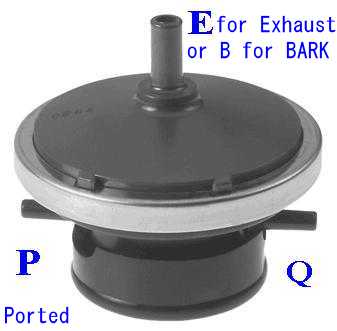 this view is upside
down.
this view is upside
down.This part rarely fails:
"P" nipple , the "Q" nipple , left and right and the top nipple is the exhaust back pressure monitor.
Do NOT pull the lid to clean the tiny air filter until you mark the bottom here with the words, P or Q or you will sorry.
Mind your P's and Q's , LOL.
P= pressure side (VSV) and vacuum.
Q= EGR main Side to its nipple.
This MOD valve fine tunes the EGR operation , by the function of exhaust back presssure on that top nipple, show above.
The CAT converter must be in place and working. Not missing or blown out or rodded out.
The stock CAT and most aftermarket CAT's supply this needed back pressure. CAT = Catalyst Converter,or CatCon
The ECU is tuned for this system and will not run correctly without it. (Hard coded into the ECU fuel and spark MAPS)
Fooling the fuel maps is not something easy or cheap to do , so fix that busted EGR.
This EGR MOD valve , will flood to much exhaust gas into the engine if the exhaust back pressure is zero. A killer default issue.
This is never mentioned in any manual. The valve is open by default !
READ this document to test the MOD valve and all tests to be done for this EGR function.
For the really curious I have the GM 96 + P0400 Monitor rules here in zip format.
This document shows how to test all EGR functions, I recommend downloading it and printing out the 9 pages.
It has many errors and I tried my best to correct them.
The EGR on the 8v engine looks just like this:
Other reasons for EGR Monitor , to cry wolf: or FALSE POSITIVES:
Are YOUR Vacuum tube routing , scrambled? All N.American cars have this sticker ,of the vacuum tubes in the engine bay.
More P0400 / DCT 51, cry wolf issues:
Bad TPS, or other sensors in bad condition.
This causes the monitor to start when it should not. See P0400 rules above for a clue, as to what other sensors can do wrong to foul up the P0400 test.
MAP , MAF, RPM readings, VSS, TPS , must all be accurate. Just to name 5.
The 16v (not all) have a MAP sensors just for testing the EGR only.
The OBD2 system as a feature called, FREEZE FRAME, if P0400 hits, you can see which of the 2 tests failed and why.
This is a key point ,the EGR can fail or the Monitor can start testing the EGR at an illegal point.
Keep that in mind.
The Readers Digest LIKE (style) ( Short list).
THE LIVE TEST PROCEDURE:
1989 - 1998: (exceptions noted)
Nut shell ECU hard coded Rules, for testing the main EGR valve: " 51 and P0400 rules ) "one liners"
The below conditons must be true or the monitor will not run.
1-Less Than 8200 feet altitude ( below Breckenridge, CO.?)
2- RPM Greater-Than 3500 (transmission types, vary speed ,see P0400 rules above) )may be lower on older cars than 96.
3 -Engine Temperature Greater-Than 136 deg 89-93 or GT 149 deg. 94-96
4- Not idling, not W.O.T., yes cruising fast. (NOT wide open throttle). Stable throttle , no wiggling right foot allowed.
5- The wheels (rear) (VSS) must turn on 94-96+ yr (on jack stands , running) HELPER needed for operating throttle, (maybe).
If your ECU has been upgraded to newer unit, this rule will apply. Applies to all Calif cars, and all above 1995.
5a: The early cars below year 94, can be live tested in Neutral/Park at zero MPH , brakes set in your drive way.
Watch (Live) The Main valve open at high rpm , as low as 2500.
Once the above rules HAPPEN, you can see the EGR valve start to open , use a mirron 16v engines to see this, and the valve will open further as you increase load on the engine. Easy to see on all 8v engines. Super easy.
Other conditons, rules , and exceptions:
- - EGR Mod., must find some exhaust backpressure . (with out proper back pressure the EGR MOD WILL FAIL to open properly)
- ( good luck if you run straight pipes and a cherrybomb or other heavy mods, or a rodded out CAT)
- - EGR Parts all good, passages must be clear, on 96-97 passages must be SUPER clean. (fails on minor restrictions, on newer cars).
- - Below 94 only Cal cars produce code 51. Thermo probe bad or EGR not opening.
- - 94 & 95 all kicks can give a code
51. on 96 and
above, it's
all states and all cars, code P0400 and VSS must click (MPH not =
0)
- - 1996/97 cars the passages must be clean , very clean, there is a hidden port , behind Throttle plate, block Butterfly open and clean it orifices.
P0400/51 Monitors history:
Old cars (pre 94) monitor the MAP sensor for EGR operation. ( if at all)
94-98 cars , monitor the EGR with MAP, Thermal sensors.
The latest cars, use Short term fuel trim measurements while conducting EGR tests. 99 or newer cars. (?)
Some countries have no EGR valve at all , and a special ECU for the same. "Africa, South America, and others" E01 market codes?
Keep in mind what your EGR does, is completely Dependant on the computer software of the ECU. Absolutely true.
The ECU has many different Smog monitors , even for the same car and varies by country and or State..
The web page does not replace a factory FSM, it only shows what is missing in the factory documentation. Cleaning procedures are not detailed in any FSM.
The 8v VSV valves look like this on my car: Photo #4:
 click
to zoom
click
to zoomThe 16v is simular but rotated to front of engine.
To test this VSV valve, I do this:
Totally completely clogged with carbon. 1991.
See the red mark below? , this POINT , too, loves to clog. See arrow below. This is the MOD valve Nipple.
Photo #6:
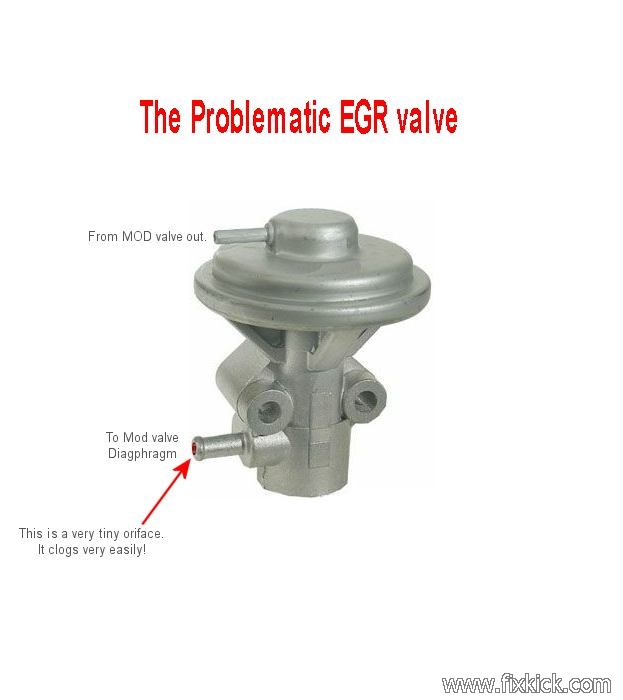
Contributors ! Thank you !
Dan demonstrates careful cleaning....
1996 to 1998 (at least);
SEE THAT GREEN TIE WRAP, that hole in there MUST BE FULLY CLEAN !!!
By: Dan Cove: ( thanks Dan !)
That zip tie is inserted at the bottom flange pipe connection port, bottom of Intake man.
Photo #7
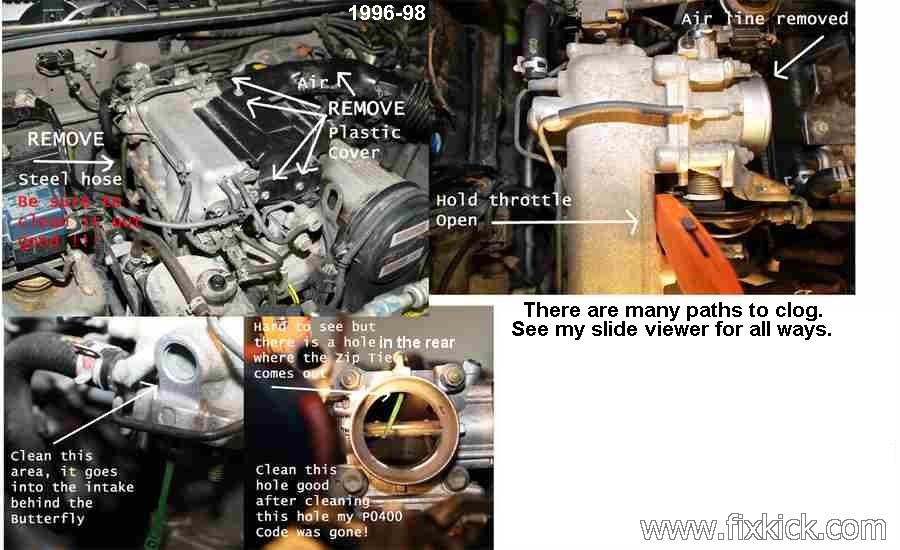
1998 shown ! code P0400. Gone in 20 miles, code resets self !!! (Typical of all 96 to 98 kicks)
And last and not the least the infamous 1996 to 1998 EGR bottle neck port that loves to clog.
Get a flash light and look here first !
1997 here. (typ. 96-98) THROTTLE BODY (TB code SAE)
Photo #8 Up is Up in view: (TPS is on right) THE THROTTLE IS BLOCKED OPEN !
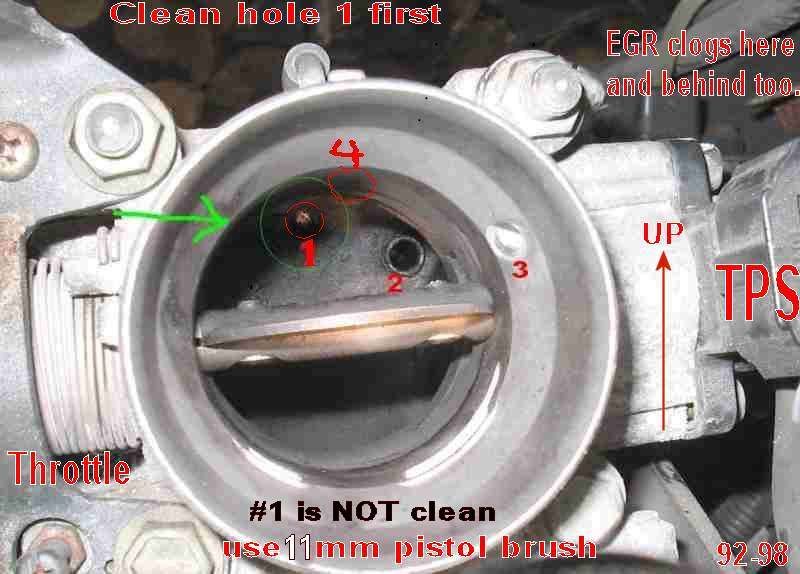
1 = EGR Exhaust port orifice (top #1 spot to clean.)
2 = Master cyl. vacuum booster brake port.
3 = Idle speed adj. bleed hole.
4 = EGR VSV hose (this is the ported EGR vacuum source that passes through the EGR VSV valve)
The top rubber hose (outside body) is the EGR ported vacuum and has a hidden top port in side , looking up. (#4)
Thanks to :deeznutts and fuzzy1 and all others posted here and on other forums, for finding out these facts !
If you can't see the #1 hole, at all, it is CLOGGED UP. Clean it out. no cost to do that at all , its just carbon in the hole.
Courtesy of Mr. Bruce Bolivar ( Thank you Bruce for you beautiful and perfect photo !!!) of suzuki-Forums.
Nothing beats photographs. ( and edits by all mentioned above)
wow !
My EGR repairs, to my new 96' Tracker.
- I cleaned port 4, that lasted for 500 miles then P0400.
- I found the metal gasket hanging at 45 deg angle on bottom
of SST tube. (allowing air in and exhuast out, as #4 cyl. pulses away)
- I found SST tube,bottle necked with carbon at the clamp ( cold spot this is, and makes for carbon pile up there)
- Cleaned upper port from back side. 1hour job.
- Photos below including 22 inch 1/8" steel rope.


click to zoom above photos.
The wire twist cable can do the whole job, not removing anything else. (even port 4 above in red)
Place the bottom tube gasket by hand and then look with mirror. Why guess?
all are 10mm nuts, cept clamp screw with is 10mm hex screw.
Double edge sword, easier to clean than 95 and back but fails more often.
1992-95 with full intake cast in EGR paths: ( Bless you MIKE )
Some people do not have the SST steel tube (direct above) but they have this crazy plumbing below. (bad news)
The SST tube clogs too ,but is a 15min clean job. How to clean the below is any wonder !
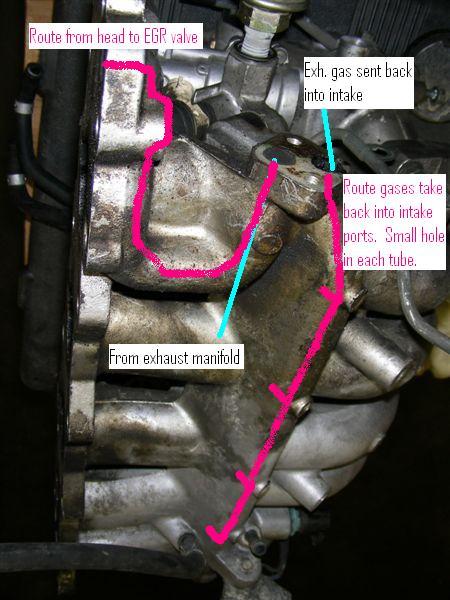
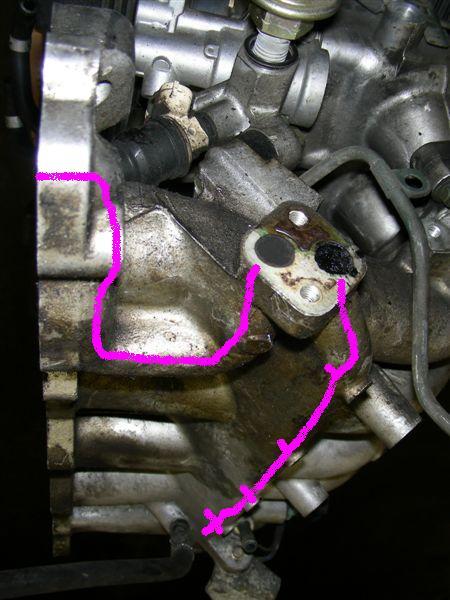
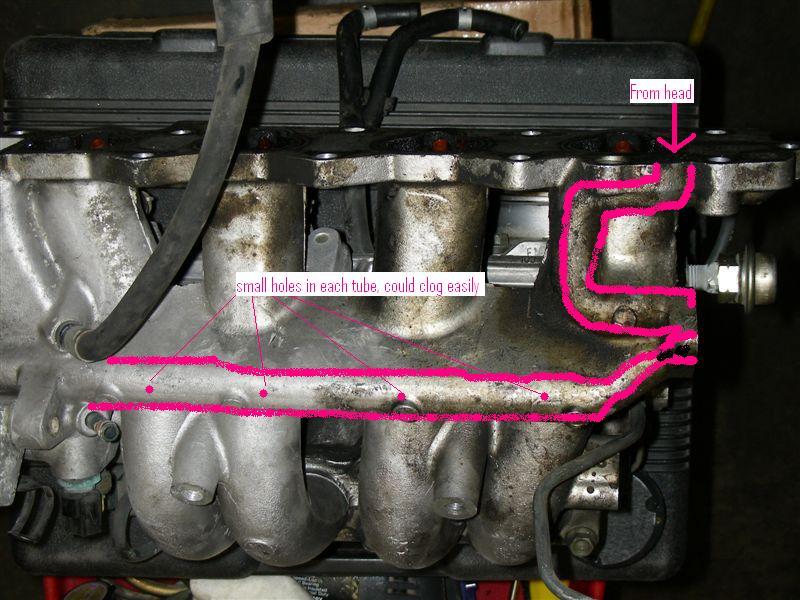
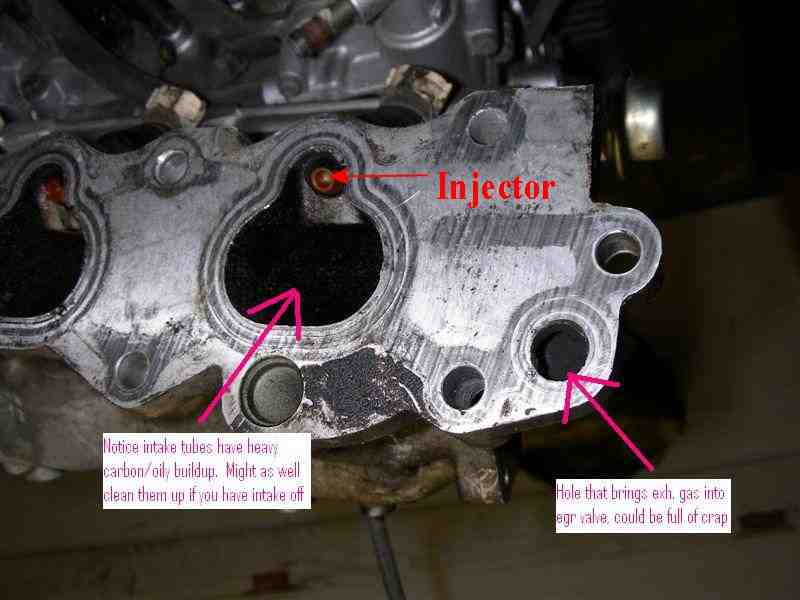
The FSM is clueless to any help for this information.
Those inside intake runner orifices have got to be a bummer. A Major Bummer. I knew him.
All I say is , OUCH !
Rev 14 , 6-24-2009